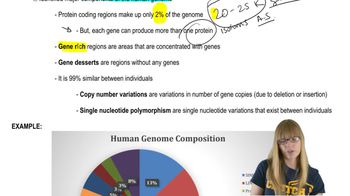Fill in the missing nucleotides (so there are three per block) and the missing amino acid abbreviations in the graphic shown here.
Table of contents
- 1. Introduction to Genetics51m
- 2. Mendel's Laws of Inheritance3h 37m
- 3. Extensions to Mendelian Inheritance2h 41m
- 4. Genetic Mapping and Linkage2h 28m
- 5. Genetics of Bacteria and Viruses1h 21m
- 6. Chromosomal Variation1h 48m
- 7. DNA and Chromosome Structure56m
- 8. DNA Replication1h 10m
- 9. Mitosis and Meiosis1h 34m
- 10. Transcription1h 0m
- 11. Translation58m
- 12. Gene Regulation in Prokaryotes1h 19m
- 13. Gene Regulation in Eukaryotes44m
- 14. Genetic Control of Development44m
- 15. Genomes and Genomics1h 50m
- 16. Transposable Elements47m
- 17. Mutation, Repair, and Recombination1h 6m
- 18. Molecular Genetic Tools19m
- 19. Cancer Genetics29m
- 20. Quantitative Genetics1h 26m
- 21. Population Genetics50m
- 22. Evolutionary Genetics29m
1. Introduction to Genetics
Fundamentals of Genetics
Problem 26
Textbook Question
Four nucleic-acid samples are analyzed to determine the percentages of the nucleotides they contain. Survey the data in the table to determine which samples are DNA and which are RNA, and specify whether each sample is double-stranded or single-stranded. Justify each answer.
[A table of nucleotide percentages appears below the problem]

 Verified step by step guidance
Verified step by step guidance1
Examine the table for the presence of thymine (T) and uracil (U). DNA contains thymine but no uracil, while RNA contains uracil but no thymine.
Identify samples with thymine (T) and no uracil (U). These samples are DNA. For example, Sample 1 and Sample 4 contain thymine and no uracil, indicating they are DNA.
Identify samples with uracil (U) and no thymine (T). These samples are RNA. For example, Sample 2 and Sample 3 contain uracil and no thymine, indicating they are RNA.
Determine if the samples are single-stranded or double-stranded by checking if the percentages of adenine (A) and thymine (T) or uracil (U) are equal, and if the percentages of guanine (G) and cytosine (C) are equal. Equal percentages suggest double-stranded nucleic acids, while unequal percentages suggest single-stranded nucleic acids.
Apply the above criteria to each sample: Sample 1 and Sample 4 have equal percentages of A and T, and G and C, indicating they are double-stranded DNA. Sample 2 and Sample 3 have unequal percentages of A and U, and G and C, indicating they are single-stranded RNA.
 Verified video answer for a similar problem:
Verified video answer for a similar problem:This video solution was recommended by our tutors as helpful for the problem above
Video duration:
2mPlay a video:
Was this helpful?
Key Concepts
Here are the essential concepts you must grasp in order to answer the question correctly.
Nucleotide Composition
Nucleotides are the building blocks of nucleic acids, consisting of a sugar, a phosphate group, and a nitrogenous base. In DNA, the bases are adenine (A), guanine (G), cytosine (C), and thymine (T), while RNA contains uracil (U) instead of thymine. The relative percentages of these nucleotides can help distinguish between DNA and RNA samples.
Recommended video:
Guided course

Human Genome Composition
Single-Stranded vs. Double-Stranded
DNA is typically double-stranded, forming a double helix structure, while RNA is usually single-stranded. The presence of thymine in DNA and uracil in RNA is a key factor in identifying the type of nucleic acid. Analyzing the nucleotide percentages can indicate whether a sample is likely to be single-stranded or double-stranded based on the presence or absence of specific bases.
Recommended video:
Guided course

Double Strand Breaks
Base Pairing Rules
In DNA, adenine pairs with thymine, and guanine pairs with cytosine, which is essential for the double-stranded structure. In RNA, adenine pairs with uracil instead of thymine. Understanding these base pairing rules is crucial for interpreting the nucleotide composition data, as they provide insights into the structural characteristics of the nucleic acid samples.
Recommended video:
Guided course

Base Distortions
Related Videos
Related Practice
Textbook Question
734
views


